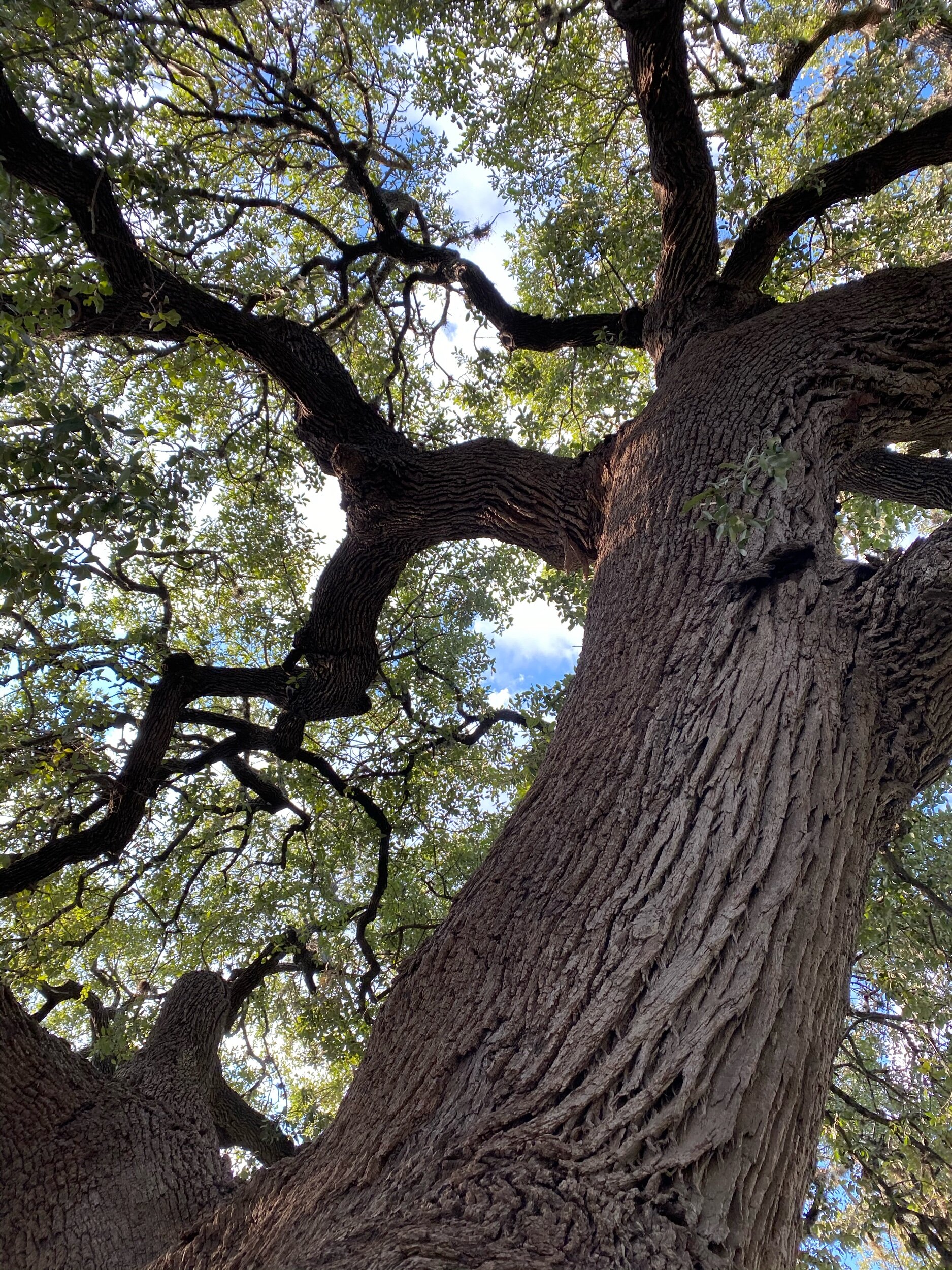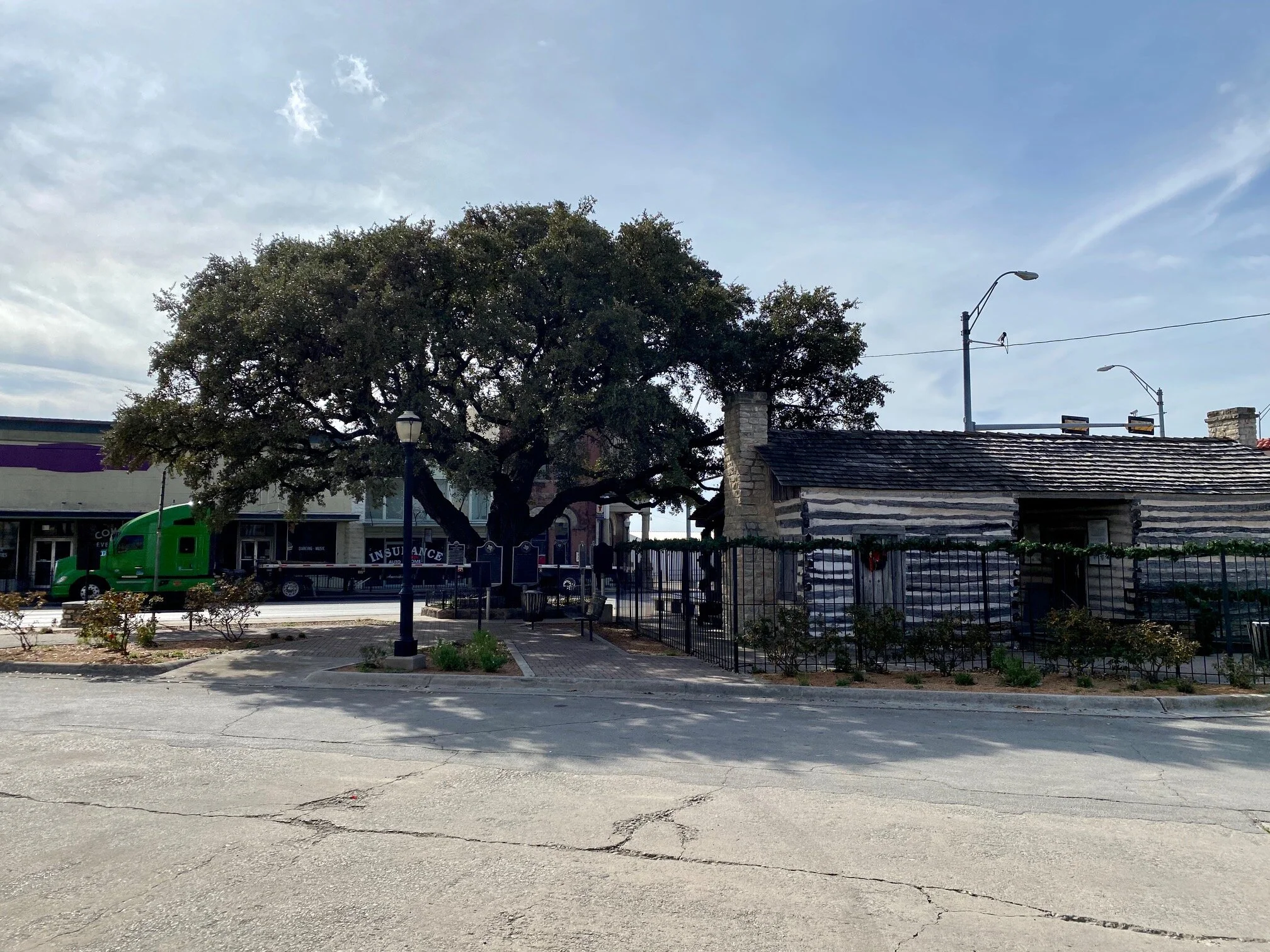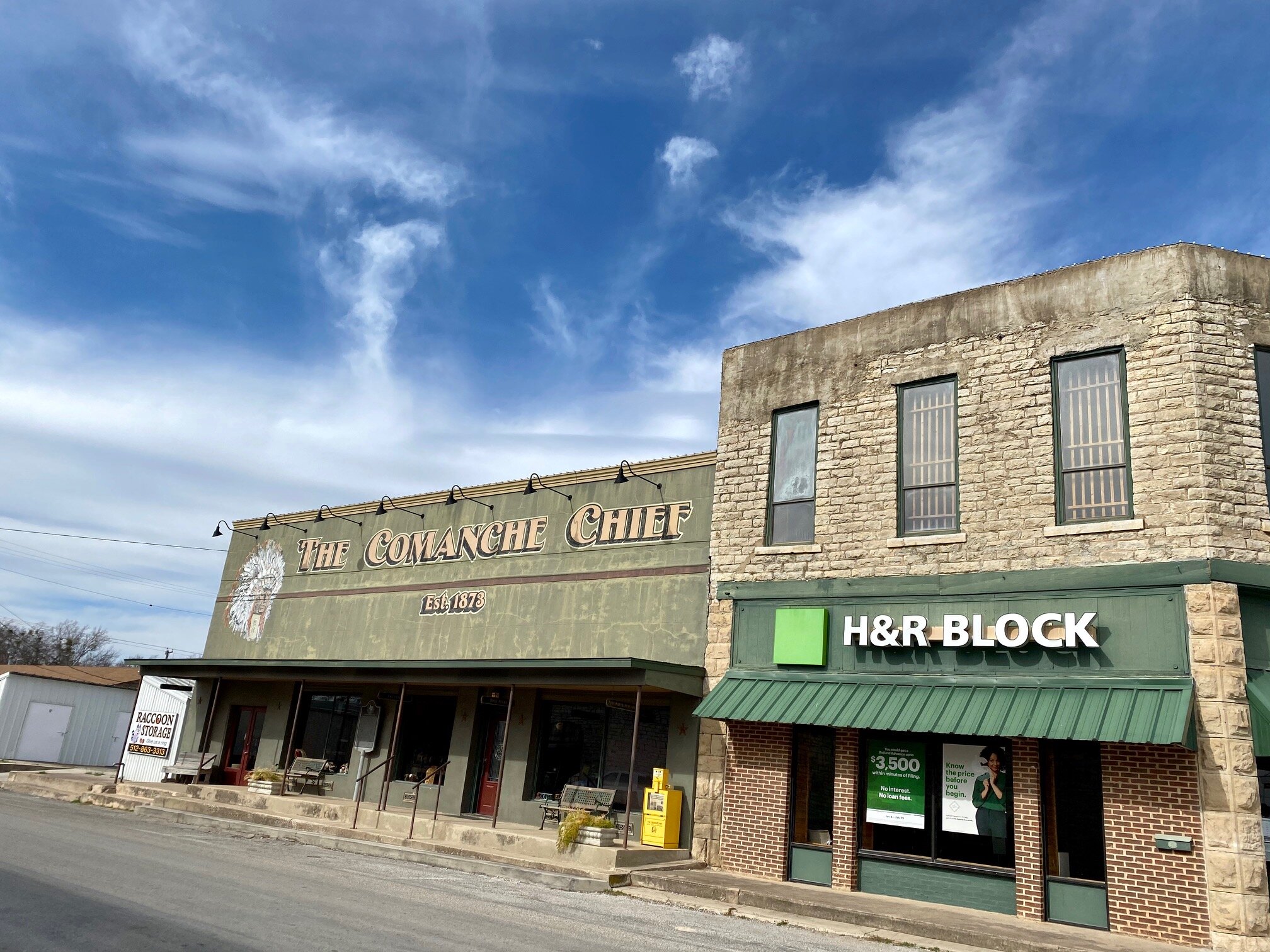
Trader’s Oak II
My second view of this magnificent Fort Worth live oak
After a bit of a let down at the Steel’s Tavern Oaks, my dear niece and I swung by to visit this big live oak. Seeing it again, I felt a sense of progress remembering the trepidation I felt beginning this project.
I knew it was an amazing specimen the first time I saw it, but now after finding others from the book, the grandeur of its wide spread and the bulky heft of its trunk was even more impressive. Unlike many which have been roped off, you can walk right under the canopy of this live oak and observe its interesting branching structure which is not visible from a distance.
Choctaw Robinson Oak
Who the hell pruned this poor thing? And why was it named for a random blow hard?
These historical designations occasionally seem arbitrary.
Why was a random preacher, William "Choctaw" Robinson, worth remembering and why did he get a tree named for him?
Apparently something of a blowhard, this Robinson guy gained notoriety for his long-winded sermons and experienced some difficulty convincing folks to listen to him. He once managed to gather some native Americans from the Choctaw tribe to sit through his service. According to legend, these braves left before he finished, one after the other. They’re quoted as saying, “white man lie” and “talk too long.” After this apparently memorable incident, he was dubbed “Choctaw Bill.”
Having earned a name for himself, he showed up whenever the spirit moved him to preach under this live oak (Quercus fusiformis), which assured him an audience, as it not only provided rare shade from the scorching Texas sun, but was near a saloon, post office and general store.
Of all the grand, beautiful and interesting trees in the Lone Star state, why did this one get singled out because some big mouth appeared underneath it when others happened to be around?
Ok, he set up a number of local churches. The account on the embossed bronze plaque is more charitable than the book but, this tree left me with many unanswered questions.
Is he remembered because of his association with religion?
Why would non English speakers even agree to sit through the ramblings of Choctaw Bill?
Did the gun have anything to do with it?
How many visitors ever pay respects to this tree out in the middle of nowhere?
Surrounded by a metal fence in a little alcove created especially for the tree, the oak is visible from the road. None of the amenities mentioned remain.
I’m guessing that this is the edge of private land?
Who owns it?
A limestone wall surrounds the the marker at the trunk base. Was there some kind of a ceremony when this plaque was placed here?
History is a new interest for me, but I have always been drawn to a personal account. Along with his well known fiction, such as Lonesome Dove and my favorite, The Last Picture Show, Larry McMurtry penned riveting non-fiction as well. Seeking guidance for this state based project, I revisited a book of his essays on Texas called In a Narrow Grave.
Ok, total tangent here… but a great read, especially if you enjoy memoir. The piece called Eros in Archer County hilariously documents how the folks he grew up with dealt with the subject of sex. This account not surprisingly includes the topics of repression as well as the shocking, but evidently commonplace practice of bestiality when other outlets were unavailable. Eww.
My dad’s older sister, my Aunt MaryBeth, typed up her own life story of growing up on a cotton farm in west Texas while waiting on letters from her husband who was a soldier during WWII. My siblings and I cherish these stories of a time gone by and her effort remains an influence on my writing.
After finding the Fleming Oak early in the day, but still miles from Dallas, I felt hungry enough to hunt some more. As with the Halfway Oak the day before, I simply drove at a medium pace along ranch road 591 hoping to recognize it. With my mind on the visual hunt, other trees seemed notable. The area is full of live oaks and I slowed to photograph a few of these possibilities. Once I spotted the real tree it was obvious - this was it.
The old photo in the book (at the top of this page) shows how healthy both of the two Choctaw Robinson trunks once were. The first thing you notice is that one of them is now inexplicably butchered and propped up on the ground.
#crimesagainsthorticulture
Who the hell pruned this poor thing?
And Whyyyyyyy???
Was it damaged by lightning or something?
Perhaps the hope was to hold up the other trunk by leaving this one propped up against the ground?
Conspicuous splitting and some deterioration at the base doesn’t justify this use of power tools. A crime against horticulture, not to mention the name of Choctaw Bill. I completely forgot to get any video, but snapped stills and headed off to check in with my dear friends in Decatur.
🌿
This tree is located near Hazeldell, along Ranch Road 591 in Comanche County.
Fleming Oak
Thank goodness for Uncle Mart, who kept his eye on this heavily threatened oak
On my way back from visiting my friend in Abilene, I detoured to get my eyes on a couple more trees. After noting some interesting non famous trees near Buffalo Gap, I headed northeast toward Comanche, Texas where The Fleming Oak lives on the corner of the town square next to the courthouse.
From my parking spot I could already see it fanning out like a giant broccoli crown, surrounded by historical marker signs. (A slanted historical perspective is presented here, to say the very least).
Another robust Texas live oak (Quercus fusiformis), it is one of 7 trees that were “Saved from the Ax” (or Axe as the website inexplicably spells it) the Fleming Oak also belongs with 9 others in the “County Courthouse” category.
The historical marker and the book tell us that Mr. Martin Fleming spent the night under this tree when he and his father first arrived in Texas and he evidently developed a fondness for it. Gun toting Fleming was around to stop workers from cutting down “his tree” circa 1911, when paving contractors started cementing the courthouse square. They allowed the tree a tight ellipse of unpaved breathing room, which is still encroaching on its root system today.
“Uncle Mart” fortunately kept his eye on this heavily threatened oak, when a few years later some other “uninformed” citizens discussed chopping it down. Another nod to a tough Texan takin’ care of business, legend has it that he dissuaded these axe wielders with a threat to their lives.
How cool is this for dorks like me?!
Noting the limestone courthouse building with its interesting sculptural elements, after viewing from all angles, I stopped into a nearby antique store on the square. When I mentioned to the lady running the place that I had come to visit the oak, she pulled out some commemorative wooden ornaments she had leftover from a few years ago.
Of course I bought one.
She recommended I visit the town newspaper, the Comanche Chief, in a building just down the street. They still actually print the paper on a small press right there. There’s a little bookstore in front, so I bought copies of Rare Plants of Texas and Texas Trees, as well as a fold up paper map of Texas, which, you never know, might come in handy when technology fails me.
Scanning the menu for anything remotely healthy in the florescent lit, barn-like restaurant across the street, I sat flipping through Rare Plants and felt like an outsider. What is it with small towns and crappy food?





























































